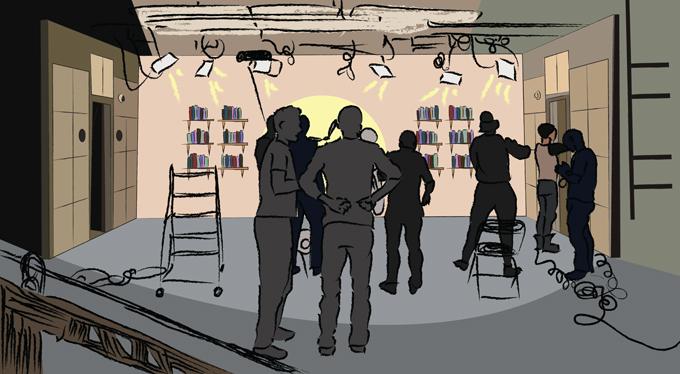Three university-age men are gathered in an apartment, drinking beers and chatting. Charles Hutchings is leaning against a large panelled window facing his two companions.
He’s holding a can of Pabst Blue Ribbon and laughing at his friends.
Across from him, in the corner, sits Kelso Gerhard in a decrepit black leather chair, legs draped over one arm, cream ale in hand.
Next to him, Nikolay Michaylov occupies a beat-up red leather couch, a warm glow cast upon him from a lamp.
He’s framed perfectly by three graduation photos of random people that Hutchings bought from Goodwill. In fact, the entire apartment is decorated with these kinds of photos and they’re all covered in doodles. A shirt dries, hanging off a set of four-foot-wide, wall-mounted moose antlers. The apartment smells of incense and Pine-Sol. Two cats, a calico and a tabby, lounge like princes. It’s Halloween night, but no one is going out.
That’s because they’re film students, and they, like the rest of their year, can look forward to spending up to $10,000 on their final thesis films over the next two semesters.
These final projects are designed to be calling cards into the industry, but the only problem is, students say, that Ryerson can’t provide the equipment necessary to create products that will be viable competitors in film festivals.
“You’ll never see a good film made [solely] with the gear at Ryerson,” says 21-year-old Hutchings.
He explains that if you have an idea for a film that would cost $8,000 to shoot on modern equipment but use only $2,000-worth to do it, it’ll definitely show.
Between him and about 70 other students in his year, there’s one industry-standard camera body (lenses and grip equipment not included) and a bunch of other outdated supplies to squabble over. The project requires each student to participate in the making of a short film that is supposed to “provide a filmmaking experience that mirrors as closely as possible what students can expect to encounter in the film industry upon graduation,” according to the course outline.
“Having high production value doesn’t make for a good film, although some people are under that delusion,” says James Warrack, who’s taught the course for the last 10 years.
He is well aware that students feel their big break into the industry is through these films, though he says that the school provides an enormous amount for the students.
If they’re choosing to rent from outside companies, they can probably get away without doing so he says.
The course outline states that the maximum expenditure for producing each film is $10,000 to cover all outlying costs. This budget is largely spent on a camera rental (to purchase it would be $40,000, and it’s a “more affordable” model), rental equipment, location, craft services (food) and the art department (which includes costumes and sets).
“It’s a lot of money for a person,” says Thea Hollatz, a 21-yearold film student. “But, it’s not a lot of money for a film.” The size and type of production is one of the factors that affects budget. Hollatz is shooting a stopmotion film to avoid spending money on an industry-standard camera, and Hutchings is shooting handheld “under the facade of making an artsy film,” to reduce equipment costs.
“If you want to design a scene in which everything looks totally authentic for the time, it costs a hell of a lot more than people would expect,” says Hutchings.
His group expects to spend about $1,200 on a camera, $2,000 on the art department, $1,300 to feed the crew and actors, plus about $500 in rainy day money. Factoring in transportation, permits, festival submissions, colour correction in post-production, the total looks to be about $6,600 – just over half the cap.
“Technically, (students) can’t afford to make these films,” Hutchings says. “But, we make it work.” He adds that students generally have no problem paying off the films, but the $10,000 tuition they spend for the year is another story.
In 2009, one student raised $95,000 (with help from outside investors) to shoot a Holocaust film called So Soon Forgotten.
They rented an antique train, had Nazi uniforms flown in from British Columbia and an actor flown in from Germany. Warrack shows the film as an example to his students; despite how authentic the film looks and its gorgeous cinematography, the story itself fell very flat. So Soon Forgotten is part of the reason why a spending cap was enforced five years ago says Warrack.
“I think that particular student thought that high production value was going to make the film,” Warrack says.
Instead, he places importance on having a solid script complete with developed characters, story arch and a way to engage the audience. The point of having the spending cap is not to restrict student’s abilities to produce exceptional work, but to ensure reasonable amounts of money are spent given the project’s nature. Any lower of a budget would be unrealistic, says Alex Anderson, interim chair of the school of image arts.
“If you have to stop half the film from being made because the budget is out of control, that is an unreasonable fourth-year class,” Anderson says.
Janelle Carpenter, 21 and her group have been preparing their thesis since the summer – getting their script done, locations scouted and pre-production well on the way. They launched a crowdfunding campaign about a month ago to finance the film and have raised about $3,700. Their expected budget is around the $10,000 mark.
“We had no idea about how grand the costs would be, in terms of rentals and how little the school would be able to provide for us in terms of equipment,” Carpenter says.
Students are expected to finance their own thesis projects, leading to the discord between how much is provided to them and what they pay for. Hollatz plans on financing the $4,000 she’ll need for her film through crowdfunding as well.
She’s also taken out a student line of credit for immediate purchases and expenses.
“I’m a really special case in that I might spend $0 on my production,” says Hollatz.
Most students are relying on a mix of different sources to fund their films.
Crowdfunding options like Kickstarter and Indiegogo are popular. Besides that, students can take out loans, open up lines of credit or just contribute their own money made from working part-time.
“You’re pitching more money than you could possibly make in a summer working minimum wage,” Hollatz says. And although the total budget is somehow divided between group members, it’s usually the director and producer splitting the bulk of the costs.
Hutchings has a different game plan. His group will target potential investors. If he needs immediate cash, he will also take out a low interest line of credit. If all else fails, he’ll contribute “hopefully maximum” two grand of his own money into the film.
“You don’t have to be in the position where you’re throwing a bunch of money at a thesis project,” says Darragh McDonald, a 2006 Ryerson film alumni.
Students have the option of streamlining into six different roles – three major (such as a screenwriter or cinematographer) and three minor (makeup artist or production assistant, for example).
These roles generally don’t demand as much of a monetary contribution as a producer or director role.
And even though there was no spending cap, crowdfunding was virtually unheard of back then – McDonald himself had a $5,000 budget for his thesis. It was well received in school but, despite being sent to about 20 festivals, it didn’t “get legs outside of Ryerson.” But his 2010 film, Love, Marriage and Miscarriage made it to TIFF.
“I didn’t expect much after my fourth-year film had such little success with film festivals,” Mc Donald says. But now he works writing closed captioning for television on a freelance basis and directs films in his spare time.
Instead of funding his endeavours directly from his pocket, he applies for grants from arts groups including the National Screen Institute, the Canada Council for the Arts and the Ontario Arts Council.
Applying for grants sometimes may not even be necessary – a successful film can be made with as little as $40.
Keith Hodder, a 2012 radio and television arts graduate, did exactly that with his 2013 film, Rift. It’s six minutes long, features a single scene and has been featured in nine film festivals (out of over 28 applied to), with one honourable mention.
His fourth-year practicum was a different story. It cost about $8,700 and was called Shift. “Shift only did two (festivals), which is very disappointing,” Hodder says.
Students can often feel that such a cumulative, momentous school project will define their post-university careers. And to create one in such a short amount of time is almost dizzying.
Before first semester of fourth year starts, many scripts are complete. The first day of school involves pitching the scripts and projects themselves. The script is read, gutted, critiqued and rewritten.
Meanwhile, fundraising starts.
Pre-production happens. Two phases of greenlighting occur before clearance for production. Then there’s casting and rehearsals. Then to camera for an insane week. That requires building the sets, shooting and tearing everything down in 7 days or less, as per the course outline.
This is followed by two months of editing. It starts with a rough assembly of the footage according to the script. Next comes a lot of nitpicking and rearranging.
Then there are voice-overs and automated dialogue replacement – when audio from a scene isn’t satisfactory, actors come into the studio, watch a clip on loop repeatedly and record their voice over the footage for better quality.
Then audio is mixed, transitions are added and final tweaks are made to the film.
Press release kits are made and submitted to as many festivals as possible. The students have a final wrap party. And after the last day of production, all the equipment is returned. Everyone finds out how much debt they’re really in as a result of their year.
Once all that is done, they receive a grade and a diploma. Then all the students can lay those 15 some-odd minutes to bed, and do it all over again with the next film.
“We’re aware that everyone thinks we’re getting a useless degree,” says Hutchings. “But we’re doing it because we love it and would hate doing anything else.” He says film students are perfectly aware of the monetary commitment that’s expected of them and that they see it as an investment.
He adds that many of Ryerson students are in the same boat, with programs like photography and fashion design.
It’s no secret that having better equipment – and more of it – would help students go further in their endeavours. Perhaps they wouldn’t feel such a great compulsion to spend money on equipment that their tuition could pay for.
Perhaps, should they be relieved of that pressure, they could fulfill instructors’ wishes even further and focus more energy on their productions, making them bigger and better.
“Film school is like four years of build up punctuated by the prospect of not getting a job at the end of it,” Hollatz says.
“So, you feel this compulsion to make the biggest, best thing you possibly can, all the time.”











Charles
Oh boy.
“What can be misunderstood, will be misunderstood.” I guess.
Dasha
Charles – what part here was misunderstood, maybe I can clarify?